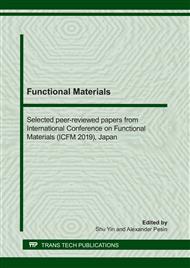[1]
G. Wei, X. Zhang, F. Yu. Effective Thermal conductivity analysis of Xonollite-aerogel composite insulation material, Jouranl of Thermal Science, 2019, 18(2): 142-149.
DOI: 10.1007/s11630-009-0142-1
Google Scholar
[2]
X. Lu, M.C. Ardunini-schuster, J. Kuhn, et al. Thermal conductivity of monolithic organic aerogels, Science, 1992, 255(5047):971-972.
DOI: 10.1126/science.255.5047.971
Google Scholar
[3]
M. Schmidt, F. Schwertfeger. Applications for silica aerogel products, J. Non-crystalline Solids, 1998, 225(1):364-368.
DOI: 10.1016/s0022-3093(98)00054-4
Google Scholar
[4]
Y. Akimov. Fields of application of aerogels(Review), Instruments and Experimental Techniques, 2003, 46(3):287-299.
Google Scholar
[5]
I. Levin, D. Brandon. Metastable alumina polymorphs: crystal structures and transition sequences. Journal of American Ceramic Society, 1998, 81(8): 1995-2012.
DOI: 10.1111/j.1151-2916.1998.tb02581.x
Google Scholar
[6]
N. Al-Yassir,R . Le.Thermal stability of alumina aerogel doped with yttrium oxide,used as a catalyst support for the thermocatalytic cracking (TCC) process: An investigation of its textural and structural properties, Applied Catalysis, 2007, 317: 275 -283.
DOI: 10.1016/j.apcata.2006.10.030
Google Scholar
[7]
R. Baetens, B. Jelle, A.Gustavsen. Aerogel Insulation for Building Applications: A State-of-the-art Review. Energy and Buildings, 2011, 43(4): 761-769.
DOI: 10.1016/j.enbuild.2010.12.012
Google Scholar
[8]
A. Soleimani, M. Abbasi. Silica Aerogel; Synthesis, Properties and Characterization. Journal of Materials Processing Technology. 2008, 199(1-3): 10-26.
DOI: 10.1016/j.jmatprotec.2007.10.060
Google Scholar
[9]
S. Bhagat, Y. Kim, Y. Ahn, et al. Rapid Synthesis of Water-glass Based Aerogels by In-situ Surface Modification of the Hydrogels. Applied Surface Science, 2007, 253(6): 3 231-3 236.
DOI: 10.1016/j.apsusc.2006.07.016
Google Scholar
[10]
J. Feng, D Chen, S. Yang, et al. Nano Silica Porous Thermal Insulating Material With SiC as Infrared Opacifier. Aerospace Materials & Technology, 2009,(1): 38-41.
Google Scholar
[11]
Y. Wang, J. Shen, J. Fricke. Preparation and investigation of highly effective thermal insulations: silica aerogels doped with TiO2 powder and ceramic fiber, Chinese Journal of Materials Research,1995, 9(6):568-572.
Google Scholar
[12]
P. Twari, A. Hunt, K. Lofftus. Ambient-temperature supercritical dryding of transparent silica aerogels, Material Letter, 1985,3[9]:363-367.
DOI: 10.1016/0167-577x(85)90077-1
Google Scholar
[13]
H.Hu, L. Gan, G. Li, et al. Supercritical drying technology, Laboratory Research and Exploration, 2000,2: 33-35.
Google Scholar
[14]
X. Sun, L. Jia, Y. Zhang, et al. Preparation of Al2O3 Aerogels with Solgel Method, Journal of Zhengzhou Textile Institute, 1999, 10(2):14-17.
Google Scholar
[15]
G. Zhan, H. Wang. Progress on research of the application of supercritical fluid drying technology to preparation aerogels, Drying Technology and Equipment, 2008, 6(4):171-174.
Google Scholar
[16]
B. Wang, C. Yu, X. Wang. Novel technology of supercritical drying for nanoporousmaterials, Chemical Engineering, 2005, 33(02), 13-17.
Google Scholar


